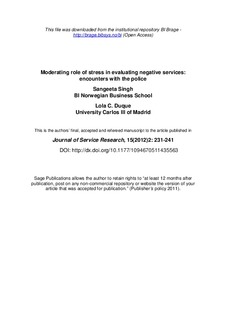| dc.contributor.author | Singh, Sangeeta | |
| dc.contributor.author | Duque, Lola C. | |
| dc.date.accessioned | 2012-05-18T12:47:10Z | |
| dc.date.available | 2013-05-01T23:00:20Z | |
| dc.date.issued | 2012 | |
| dc.identifier.issn | 1552-7379 | |
| dc.identifier.uri | http://hdl.handle.net/11250/93476 | |
| dc.description | This is the authors’ final, accepted and refereed manuscript to the article | no_NO |
| dc.description.abstract | Since negative services are usually sought during emergencies or when problems arise or to ensure against unwanted outcomes, they are typically accompanied by high levels of stress. Our study investigates the role of stress in evaluating such services. We examine citizen satisfaction with a specific negative service, police services, and the moderating role of stress in the evaluation of these services. Findings from our study confirm the moderating role of stress in satisfaction with police services, which determines the differential importance of service attributes: helping consumers manage the stress is more important for satisfaction when consumers are stressed while courtesy and speediness of service delivery are more important when consumers are not stressed. This can be the basis for training police officers to better understand the state the consumer is in and reinforce specific service features accordingly. The study adds to extant knowledge in three areas: (i) public/police services: satisfaction with a public service is valuable in evaluating government and agency performance (ii) negative services: they are an integral part of many service providers, yet understudied (iii) unpleasant affective state: people assign greater weight to unpleasant situations when making satisfaction judgments. | no_NO |
| dc.language.iso | eng | no_NO |
| dc.publisher | Sage Publications | no_NO |
| dc.subject | police services | no_NO |
| dc.subject | negative services | no_NO |
| dc.subject | stress | no_NO |
| dc.subject | pre-existing affect | no_NO |
| dc.subject | satisfaction | no_NO |
| dc.title | Moderating role of stress in evaluating negative services: encounters with the police | no_NO |
| dc.type | Journal article | no_NO |
| dc.type | Peer reviewed | no_NO |
| dc.source.pagenumber | 231-241 | no_NO |
| dc.source.volume | 15 | no_NO |
| dc.source.journal | Journal of Service Research | no_NO |
| dc.source.issue | 2 | no_NO |
| dc.identifier.doi | 10.1177/1094670511435563 | |
